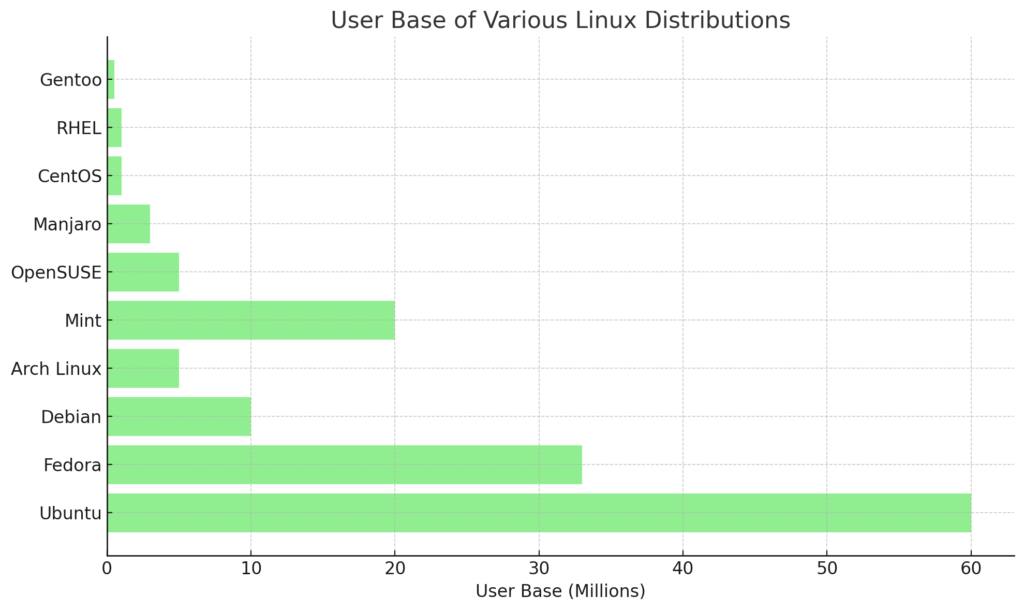
Linux Distributions User Base Analysis | Popular Linux Distros 2024
Linux distributions have solidified their place in the open-source software ecosystem, offering a wide array of options that cater to everyone from casual desktop users to enterprise IT professionals. Understanding the user base of these distributions is crucial for developers, companies, and users alike who need to make informed decisions about which Linux distribution best suits their needs. In this article, we’ll explore the current user base of various popular Linux distributions, delve into why some have gained more traction than others, and guide you in selecting the perfect Linux distro for your needs.
What is a Linux Distribution? Understanding Linux Distros
A Linux distribution, or distro, is a customized version of the Linux operating system that includes the Linux kernel along with a set of tools, software packages, and configurations tailored to different user needs. Whether you need an OS for general desktop use, server management, security tasks, or software development, there’s a Linux distribution designed for you. The diversity in Linux distributions showcases the adaptability and strength of the Linux ecosystem, allowing users to choose a version that perfectly fits their specific requirements.
Overview of Popular Linux Distributions: Which Linux Distro is Right for You?
The chart we’re analyzing today highlights several key Linux distributions, each with its own set of features and target audience:
1. Ubuntu: The User-Friendly Linux Distro
Ubuntu is perhaps the most recognizable Linux distribution globally. Known for its user-friendly interface and widespread adoption across desktops, servers, and cloud environments, Ubuntu is often the go-to choice for new Linux users and enterprises alike. Backed by Canonical, Ubuntu offers a robust ecosystem with extensive community support.
2. Fedora: The Cutting-Edge Linux Distro for Developers
Fedora is renowned for incorporating the latest technologies and software, making it particularly popular among developers and tech enthusiasts. Its close relationship with Red Hat ensures that Fedora remains at the forefront of innovation in the Linux world.
3. Debian: The Stable and Reliable Linux Distro
As one of the oldest and most stable Linux distributions, Debian is known for its robustness, especially in server environments. It serves as the foundation for many other distributions, including Ubuntu and Admirux, making it a cornerstone of the Linux ecosystem.
4. Linux Mint: The Best Linux Distro for Beginners
Based on Ubuntu, Linux Mint offers a familiar desktop environment for users transitioning from Windows. Its emphasis on ease of use and pre-installed software packages makes it an ideal choice for beginners.
5. OpenSUSE: Versatile and Reliable Linux Distro
OpenSUSE is known for its versatility, offering two main versions: Leap, which focuses on stability, and Tumbleweed, which follows a rolling release model. It appeals to users who want a balance between innovation and reliability.
6. Arch Linux: The Minimalist and Customizable Linux Distro
Arch Linux is favored by advanced users who want full control over their system. Its minimalist approach and rolling release model allow users to build their system from the ground up with the latest software, offering unmatched customization.
7. Gentoo: The Performance-Oriented Linux Distro
Gentoo is a source-based distribution that gives users complete control over the software they install, making it ideal for those who prioritize performance and system optimization.
8. RHEL (Red Hat Enterprise Linux): The Enterprise-Grade Linux Distro
RHEL is a commercial distribution designed for enterprise environments, offering stability, long-term support, and a vast ecosystem of certified software and hardware. It’s a top choice for businesses needing a reliable and secure Linux platform.
9. Manjaro: The User-Friendly Arch Linux Alternative
Based on Arch Linux, Manjaro provides a more user-friendly experience while retaining the flexibility and power of Arch. It’s a great option for users who want the benefits of Arch Linux without the steep learning curve.
10. CentOS: The Free Enterprise Linux Distro
CentOS, a free alternative to RHEL, is widely used in server environments where stability and reliability are paramount. It offers the benefits of RHEL without the associated costs, making it a popular choice in enterprise settings.
Analyzing the User Base Distribution: Which Linux Distro Has the Most Users?
The user base distribution chart reveals significant insights into the popularity of these Linux distributions:
Ubuntu: The Most Popular Linux Distribution
With nearly 60 million users, Ubuntu is the undisputed leader in the Linux world. Its widespread adoption is attributed to its user-friendly nature, strong community support, and backing by Canonical. Ubuntu’s dominance is further strengthened by its extensive use in cloud computing and server environments, making it a top choice for both personal and professional use.
Linux Mint: A Top Choice for Beginners
Linux Mint, the second most popular distribution, boasts around 20 million users. Its appeal lies in its ease of use, particularly for those transitioning from Windows. Mint’s familiar desktop environment and pre-installed software make it an ideal choice for beginners, and its Ubuntu base ensures stability and a wide range of software compatibility.
Fedora and Debian: Strong Contenders in the Linux World
Fedora and Debian both have substantial user bases. Fedora attracts developers with its cutting-edge features and rapid release cycle, while Debian’s stability makes it a favorite among server administrators and those who prioritize a reliable operating system.
Arch Linux: Power Users’ Favorite Linux Distro
Despite its steep learning curve, Arch Linux has garnered a user base of over 10 million. Its popularity among power users who value customization and the latest software is evident, making it a go-to for those who want complete control over their Linux environment.
Gentoo and RHEL: Serving Niche Markets
Gentoo and RHEL serve more niche markets. Gentoo appeals to users who want to optimize their system performance at a granular level, while RHEL is a staple in enterprise environments where long-term support and certified solutions are critical.
Manjaro and CentOS: Reliable and Popular Linux Distros
Manjaro’s user-friendly approach to Arch Linux has helped it build a strong following, while CentOS remains a popular choice for servers, especially in environments where RHEL’s stability is desired without the cost.
This distribution of user bases highlights the diversity within the Linux ecosystem, with each distribution catering to different user needs and preferences.
Why Ubuntu Leads the Linux Distribution Market
Ubuntu’s dominance in the Linux landscape is no accident. It consistently prioritizes user experience, making it accessible to newcomers and seasoned users alike. Canonical’s strategy of regular updates, long-term support (LTS) versions, and a robust ecosystem of applications has solidified Ubuntu’s position as a reliable and versatile operating system.
One of Ubuntu’s significant advantages is its strong presence in the cloud computing space. Many organizations choose Ubuntu for their cloud infrastructure, particularly Ubuntu Server, extending its user base far beyond the traditional desktop environment. This widespread adoption in both personal and enterprise environments has helped maintain Ubuntu’s leading position.
Moreover, Ubuntu’s strong community support and extensive documentation provide users with the resources they need to troubleshoot issues and maximize their system’s potential. These factors, combined with a commitment to innovation, ensure that Ubuntu remains at the forefront of the Linux ecosystem.
Emerging and Niche Linux Distributions: Rising Stars in the Linux World
While Ubuntu, Mint, and Fedora dominate the landscape, emerging and niche distributions like Gentoo and Arch Linux are gaining traction among specific user groups. Gentoo offers unparalleled customization and performance optimization, making it popular among enthusiasts who enjoy tweaking their systems to the fullest.
Arch Linux has also carved out a niche, particularly among advanced users who appreciate its minimalist approach and rolling release model. Despite its challenges, Arch’s flexibility and the ability to stay on the cutting edge of software make it a favorite among power users.
RHEL and CentOS continue to play vital roles in enterprise and server environments. RHEL’s stability and long-term support are unmatched in the commercial space, while CentOS offers a free, community-supported alternative that is widely used in critical server deployments.
These niche distributions, though smaller in user base, contribute significantly to the diversity and adaptability of the Linux ecosystem.
Find Your Perfect Linux Distribution with Admirux Distro Picker Tool
Choosing the right Linux distribution can be overwhelming, especially with so many options available. If you’re unsure which distro is best for you, consider using the Distro Picker Tool by Admirux. This tool helps you find the perfect distribution based on your specific needs, preferences, and technical expertise. Whether you’re a beginner looking for an easy-to-use desktop environment or a seasoned professional seeking a customizable server solution, the Distro Picker Tool will guide you to the best choice.
The Future of Linux Distributions: Trends to Watch
The future of Linux distributions is as dynamic as ever. With the increasing adoption of open-source technologies across various sectors, the user base of Linux is likely to expand even further. Distributions like Ubuntu and Fedora are expected to maintain their dominance due to their established user bases and strong community support.
However, niche distributions may see a rise in popularity as more users seek out specialized features and greater customization. The growing emphasis on cloud computing, containerization, and the Internet of Things (IoT) will also influence which distributions gain traction, as different environments have unique requirements.
As Linux continues to innovate and adapt, the ecosystem will likely see new distributions emerging, each catering to the evolving needs of users worldwide.
Conclusion: Discover the Diversity of the Linux Ecosystem
The Linux ecosystem is rich with diversity, offering a distribution for every type of user—from user-friendly options like Ubuntu and Mint to specialized distros like Gentoo and RHEL. The distribution of user bases across these distros reflects their strengths and the unique needs they fulfill within the broader community. As technology evolves, so too will user preferences, ensuring that the Linux ecosystem remains vibrant and ever-changing. If you’re still undecided on which Linux distribution to try, be sure to check out the Distro Picker Tool from Admirux to find the perfect match for your needs.
Suggested Resources for Further Reading
- Ubuntu’s User Base and Popularity:
- Fedora and Its Developer Base:
- Debian’s Stability:
- Arch Linux and its Customization:
- RHEL and Enterprise Use:
- Linux Mint’s Ease of Use:
- General Linux User Statistics:
- Admirux Distro Picker Tool:
Share via:

